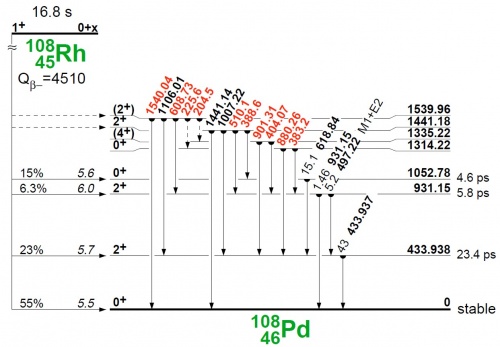Gamma Emission comes from Excited States
When a nucleus decays by emitting an alpha or beta particle the daughter product will frequently be in an excited state. The excess energy (related to the daughter's ground state) is usually released as gamma radiation. The deexitation of such excited states does not always occur directly to the ground state, but can go via lower-lying excited states. Frequently the deexcitation scheme can be quite complex, as illustrated in the figure below (copied from Table of Isotopes, eight edition), which shoes gamma transitions from excited states in 108Pd, after beta decay of 108Rh. |
| Fig 1 : Decay stages of 108Rh |
Due to the (usually) partial beta-feeding of the excited levels and the many different deexcitation paths the intensity of the emitted gamma rays will vary - from nearly 100% down to very small fractions of a percent. This must be taken into account when you analyze a gamma spectrum, the visibility of the different gamma rays (i.e. how clearly it shows up in the spectrum) depend on it's emission rate.
Detection of Gamma Rays
To understand what you see when measuring gamma rays, you need to understand how gamma rays interact with matter. This is briefly explained below. Refer to your course book and lecture notes for more details.A photon (gamma ray) can interact with matter in three different ways:
- The photoelectric effect, where the gamma energy is transferred in its entirety to an electron in one of the inner shells of an atom in the absorption material. The electron emitted has a kinetic energy corresponding to the gamma energy minus it's binding energy. The ejected (primary) electron is shot away at great speed. It's velocity decreases via electrostatic interactions with the absorbent's electrons, and thus gives off its kinetic energy to the absorber in thousands of small steps.
- The second way a photon can interact with matter is called Compton scattering. Parts of the gamma energy is transferred to out electron of the absorbent's atoms. Again the energy of the electron (Compton electron) is deposited in the absorber . The reaming energy after the Compton interaction result in a new photon. The photon can either leave the absorber or interact at some other part of it. If the photon from the Compton scattering also interacts, it will happen so quickly that normal electronics will not be able to distinguish the two events, but will record them as one event with energy equal to their sum.
- Pair formation is the third way of interaction. When a photon has higher energy than 1022 MeV an electron/positron pair may spontaneously form. The total kinetic energy of the two elementary particles are equal to the energy of the gamma minus 1022 MeV. Again the electron and positron will transfer its kinetic energy to the absorber through Columb interactions. However, as the positron is an antiparticle to electrons it will immediately interact with an electron and annihilate when it's kinetic energy is spent (then it has time "to look around" and discover that it's electrons everywhere, which is not good news for survival...!). The annihilation creates two photons of 511 keV each, moving in opposite directions. The 511 keV photons can either escape the absorber (detector) or interact with it. This will give rise to "double escape", "single escape" or "full energy equivalent" events in associated gamma spectra.